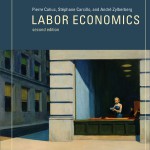Authored by IZA Program Director Pierre Cahuc with Stéphane Carcillo and André Zylberberg, Labor Economics has long become the graduate-level textbook that combines depth and breadth of coverage with recent, cutting-edge work in all the major areas of modern labor economics. The second edition, now available, has been substantially updated and augmented.
and breadth of coverage with recent, cutting-edge work in all the major areas of modern labor economics. The second edition, now available, has been substantially updated and augmented.
In an interview with IZA Newsroom, the authors provide some insights into their work:
More than 1,000 pages and lots of supplementary material – looks like a lot of work… What was your main motivation behind this book?
We wanted to provide a comprehensive textbook that could be used both in graduate and introductory classes, with a strong focus on facts, a clear presentation of the main theories and empirical methods. And ten years after the first edition, serious updates were needed.
What are the key improvements over the first edition?
The second edition is more oriented towards empirical methods than the previous one, with dedicated sections in each chapter presenting key econometrics approaches and using a different reference paper each time. A companion website (www.labor-economics.org) provides the data and the Stata codes necessary to reproduce the main results presented in the book. This second edition also presents theories and evaluations of labor market policies and institutions in more detail, with three dedicated chapters. Important issues, such as discrimination, globalization and the effect of technological progress, are also given more attention.
Did you incorporate any user feedback in the second edition?
We surely did. For instance, discussing with students and colleagues we realized that the first edition of the book was somewhat too arduous and abstract when presenting empirical methods. That is why we decided to explain them in a more concrete manner, using seminal papers and explaining them step by step.
What do you believe to be the major trends in labor economics that have shaped and will further advance the discipline?
The development of empirical methods is probably what has contributed most to changing labor economics over the last decade, and we wanted to reflect this in the book. The identification of causal relationships is often a challenge in social sciences, but the field has developed various strategies that can be useful to other disciplines. This trend is likely to strengthen in the coming years with more and more good quality data becoming available, and also with the spread of a culture of evaluating public policies. The theory is also changing: the understanding of job search behavior, labor mobility and labor market dynamics has made important progress over the last decade. Our book also reflects these advances.
===
For more information on the book go to the MIT Press page.